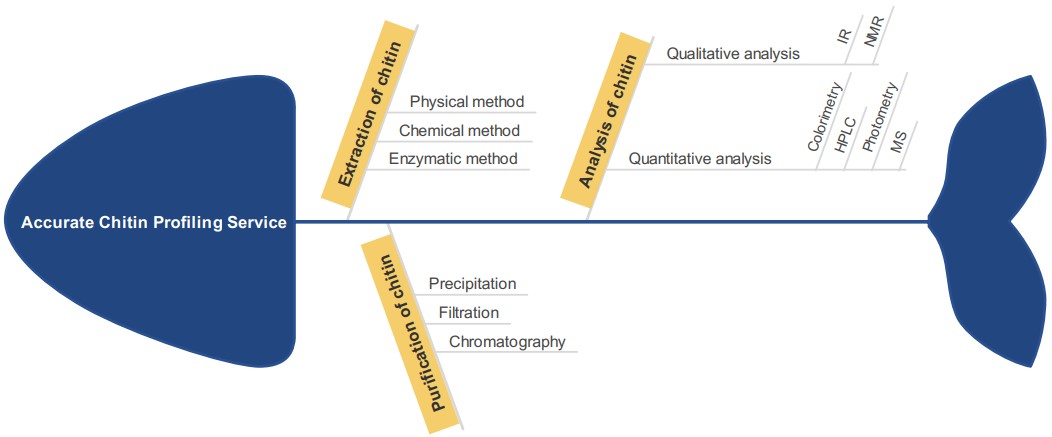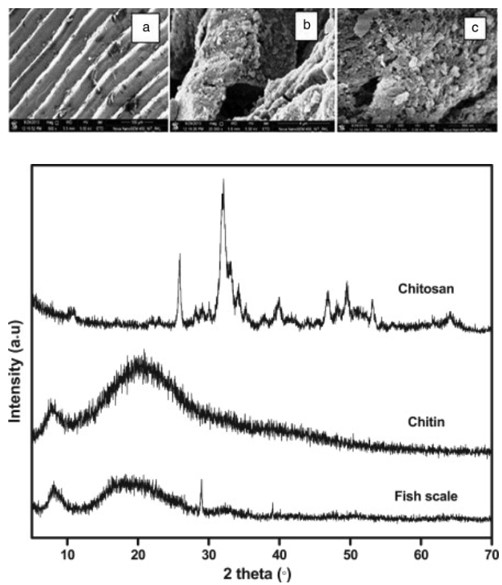Chitin Profiling Service
Services Published Data FAQs Customer Review
Accurate Chitin Profiling Service at Creative Biolabs
Chitin is widely present in the biological world and has the characteristics of biodegradability and biocompatibility. It is an important polysaccharide polymer found in biomass, especially in crustacean exoskeletons and fungal cell walls. During biomass processing, such as when processing shrimp shells, mushroom residues, and other biomass materials containing chitin, chitin may be released into the process liquid. Therefore, it is particularly necessary to analyze the chitin content in Biomass Process Liquid. Analysis of chitin helps determine the main components and content in biomass, providing basic data for further biomass utilization and processing. It can also help optimize biomass processing technology and control production conditions and parameters to maximize the extraction of chitin or adjust its content, thereby improving production efficiency and product quality. Creative Biolabs has modern laboratory instruments that support the extraction, purification, and quantitative analysis of chitin.
We extract chitin from biomass process liquid through physical and chemical extraction methods.
-
Physical extraction method: Ultrasonic technology is used to break the cell wall and release chitin. Moreover, ultrasonic waves can also help improve extraction efficiency.
-
Chemical extraction method: We add the biomass process liquid sample to an acidic solution (such as hydrochloric acid) to hydrolyze chitin, and then adjust the pH value with an alkaline solution (such as sodium hydroxide) to precipitate chitin. Final purification using appropriate detergents and solvents.
-
Enzymatic method: In addition, we also directly use enzymes such as chitinase to decompose chitin in biomass process liquid to generate products that are easy to extract and analyze.
We use techniques such as precipitation, filtration, or chromatography to purify the extracted chitin solution to remove other impurities.
-
Qualitative analysis: We conduct qualitative analysis of chitin through infrared spectroscopy (IR), nuclear magnetic resonance (NMR), and other technologies to confirm its existence and verify its structure.
-
Quantitative analysis: We use the methanol-sulfuric acid method to hydrolyze chitin into glucosamine, and determine the glucosamine content by colorimetry or high-performance liquid chromatography (HPLC) to quantify chitin. In addition, photometry and mass spectrometry (MS) are also used to accurately and reliably evaluate the chitin content in biomass process liquid samples.

Creative Biolabs has extensive professional experience in the fields of biotechnology and chemical analysis and is familiar with the properties, extraction methods, and analytical techniques of chitin. We strictly implement quality control procedures to accurately and reliably analyze chitin in biomass process liquid, and guide production process optimization and product development. In addition, we also provide analysis services for Sugar, Sugar Degradation Products, Esterification Degree, and Acetylation Degree in biomass process liquid. Please contact us in time if you need to obtain a specific service.
Published data
Shrimp shells are the main waste in seafood processing. Biomaterials with value-added potential, such as chitin, can be extracted from these shrimp shell biomass. Chitin is a new functional biomaterial that shows great application prospects in many fields such as biomedicine, food, and environment. In this study, the authors used a natural deep eutectic solvent (NADES) as a reaction medium to dissolve shrimp shell biomass, precipitate chitin, and separate its fractions from minerals. Subsequently, the purity of chitin was tested using a variety of advanced analysis techniques, and the liquid fractions after precipitation were also analyzed. The results showed that the chitin extracted using NADES composed of choline chloride-lactic acid (CCLA) had an extraction rate of 90% and a purity of more than 98%.
 Fig.1 Process of isolating chitin from shrimp shells by NADES.1
Fig.1 Process of isolating chitin from shrimp shells by NADES.1
FAQ
Q1: How to accurately collect biomass process liquid samples for chitin analysis?
A1: We recommend that you use sterile containers to collect samples to ensure that contamination is avoided. Moreover, you need to provide detailed sample collection instructions, including sample storage and transportation processes, which will facilitate the formulation of our experimental analysis plan.
Q2: What are the methods for chitin analysis? Which method is more suitable for our samples?
A2: We use a variety of methods to analyze chitin, such as acid-base hydrolysis combined with the methanol-sulfuric acid method for quantitative analysis. Depending on the nature of your sample and the purpose of your research, we can discuss it together and choose the most suitable method.
Q3: Is your analytical method capable of distinguishing chitin from other similar compounds?
A3: Yes, our analytical method is highly specific and effectively differentiates between chitin and other similar compounds. We can provide relevant experimental data to support this.
Customer Review
Strong Professional Ability
"Creative Biolabs's experts demonstrated excellent professional knowledge and technical capabilities. They quickly and accurately analyzed the biomass process liquid samples we provided and answered various technical questions for us. We are very impressed with your service and thank you for your efforts everything!"
Detailed Report
"Your laboratory team did a great job! We were very impressed with your professional attitude and efficient workflow. The detailed explanations and recommendations presented in the analysis report allowed us to better understand the chitin content in our samples, which was of great significance to our research work."
Reference
-
Bradić, Bojana, Uroš Novak, and Blaž Likozar. "Crustacean shell bio-refining to chitin by natural deep eutectic solvents." Green Processing and Synthesis 9.1 (2019): 13-25. Distributed under Open Access license CC BY 4.0, without modification.
For Research Use Only.
Related Services


 Fig.1 Process of isolating chitin from shrimp shells by NADES.1
Fig.1 Process of isolating chitin from shrimp shells by NADES.1

